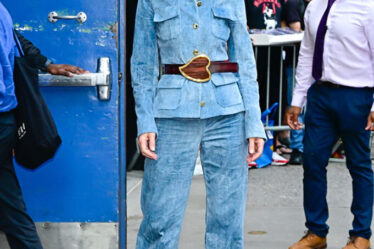
The secondhand clothes market is booming. But is it always the case that buying from secondhand shops is good for the environment?
Abigail Austin is saying “less to the dress” by taking a more considered approach to recycled clothes shopping and investing in pieces that truly resonate with her. Here are some tips from Guardian readers on how to give the right amount of love to preloved fashion.
I buy fairly little because I am happy with what I have. Here are my tips.
First, buy what you need – don’t just “go shopping”. Check your wardrobe before the season starts, and check it again a few weeks into the season.
Second, know the colours that suit you.
Third, know how to do basic mending (sew on buttons, sew up seams) and cleaning.
– Anonymous, Jerusalem
Repair before buying
I worked at two of the UK’s largest fashion retailers, on the shop floor, for 27 years. Not in well-paid positions. I learned on the job about cloth quality, garment construction and care labels.
I buy mostly natural fibres. “Dry clean only” – never buy these. Keep your clothes for years. Repair when possible. Or until really worn out. Then use for repairing other clothes, or turn into cleaning cloths. This is something those of us from the working class have always done through necessity. Not because we have to feel good about our rampant consuming of this planet’s resources. I love clothes. I also wish to look well put together. But we have never had the money to buy endless clothes.
– Marcella, London
Sew your own
I have stopped buying secondhand clothes, it became hit and miss with purchases. At this stage I would rather make key pieces like pants, tops and shirts. I purchase fabrics from thrift shops that I can use for quilts, cushions, clothing and other projects. Living in a small country town and being semi-retired, I don’t have the same requirement for haute couture, denim is de rigueur.
– Mary, regional Victoria
Know your measurements
I have shopped secondhand since I was a teenager, because I enjoy the hunt and the individuality. These days it has become so much easier to do the hunt online, whether you are looking for vintage, designer vintage, secondhand or even retro. The quality of designer vintage has suddenly become within my reach.
Knowing your measurements is the key to all good shopping, but is especially important for a successful secondhand hunt. If the seller hasn’t already provided the vital measurements in the listing, you can ask. When shopping in actual shops it is very easy to have a note with the needed information and a measurement tape if you don’t want to try it on in the shop. When you realise the wonders of having clothes fitted, as opposed to us trying to adapt yourself to the clothes, there is no going back to the cheap fix of fast fashion.
– Helena, Paris
Be rigorously selective
Secondhand shopping has been a necessity most of my life. I am rigorously selective for quality fibres. The issue is what is enough and how important is my time? This also applies to people purchasing new items. Something new can lift spirits. An honest approach to your motivations can lead to necessary soul searching. A person can spend years on autopilot being entertained by shopping and rationalising needs but meanwhile you are not creating room for more rewarding pastimes. The mind-boggling issues surrounding waste textiles (both new and old) should be front of mind.
– Deb, Melbourne
Stick to the rules
I have shopped for secondhand clothes for more than 20 years because I like good-quality, well-made minimalism. I have self-imposed rules though and maintain a modest wardrobe which supports my specific style.
The rules are: only specific brands, pure cotton or wool, in excellent condition and only items required to keep my wardrobe in good order.
I started doing the same for my husband about five years ago. We both use a mix of secondhand and quality new clothing (only buying new once key items have worn out). I do it because I detest fast fashion and poorly designed and made items, because it’s our way of supporting recognised charities, and because we are very conscious of climate impact. And we are often complimented on our appearances.
– Anonymous, Canberra
Be intentional
I’ve always been someone who’s tried to be very intentional about my shopping. I try to only buy what I truly need. Admittedly, a lot of that comes from frugality and wanting to cut down on excess spending more than a desire to be eco-friendly.
I feel, though, that it’s almost impossible to shop intentionally and shop secondhand. With a secondhand store you never know what will be there. If you go in with a clear idea of what you want/need (eg a neutral-coloured, medium-weight sweater that fits well), your chances of success are slim. Your chances are better if you have access to big-box secondhand stores like Goodwill in the US, but where I live the secondhand shops are tiny, rarely much larger than my living room. The chances of any given secondhand shop having a sweater in my size, let alone in the colour or material I want, is slim.
The way to successfully shop in these small shops is to go in with an open mind and be open to the possibilities of what’s there. That’s not inherently a bad way to shop, but it’s certainly not an intentional way to shop. As a result, I’ve never really been able to make secondhand shopping work for me.
– Meghana, Glasgow



